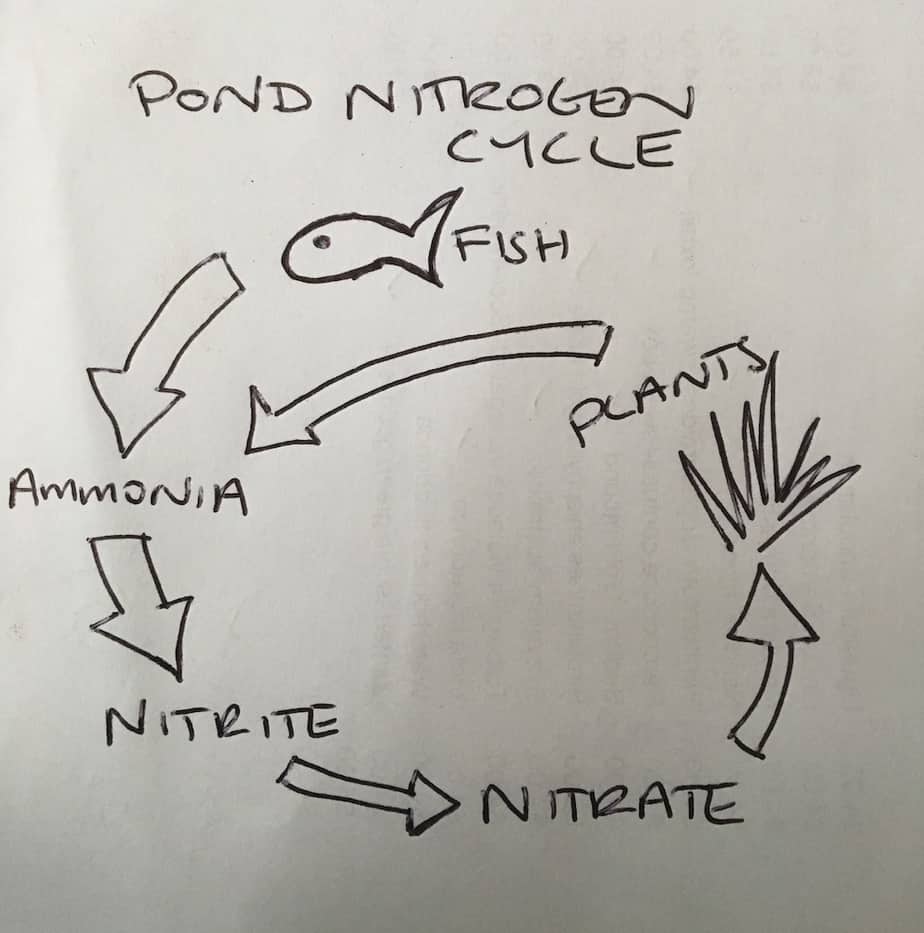If your pond has fish in it do not turn the pump off at night! However a pond without fish can safely be turned off at night.
The main purpose of a pump in a fish pond is to circulate the ponds water through some kind of filtration. There are 3 common types of filtration: mechanical, chemical and biological.
The biological element is the most important.
To understand the importance and workings of a pond filter read the article pond filters- how they work.
Without a pump and filter system the pond can quickly become unsafe for fish. The fish in a pond produce ammonia. Ammonia even in small doses can be fatal for fish. Biological filters process ammonia into nitrite and then the nitrite into nitrate.

This is a natural process known as the nitrogen cycle. Everyone who keeps fish whether in an aquarium or pond needs to understand the nitrogen cycle. I wrote a beginners guide to the nitrogen cycle if you need to learn more.
The second reason to run your pump 24/7 is, fish need oxygen. The pump will be providing oxygen as it agitates the water allowing the air to mix with the water.
What if I add plants?
Some plants are sold as oxygenator. During the daylight hours these plants will provide oxygen to the water. Yet overnight when there is no photosynthesis occurring the plants actually draw oxygen from the water.
Don’t get me wrong I think every pond should have plants. Plants provide shade and help consume excess nutrients. By consuming nutrients and providing shade they compete with algae and provide a healthy well balanced ecosystem.
Adding plants to a pond also adds extra biological filtration as bacteria colonises the roots. Not to mention they provide food and shelter for the fish and other aquatic life.
It can be possible to have a pond that doesn’t require a pump i wrote an article on the topic.Then main take aways are plenty of plants and surface area for bacteria. Of course its much easier to maintain pristine water quality with a pump.
Ponds that can be shut off at night
So the best types of ponds that can be shut off at night are ponds without fish.
Now here’s the thing a pond without fish could possibly become a breeding ground for mosquitoes. Mosquitoes love stagnant water for breeding. Now if your water isn’t being circulated it’s stagnant.
But if you don’t want to keep fish but you want a water garden or the sound of water consider installing a pond less system.
Pondless you say?( click this link to check out a pondless kit)
Yeap pond less water features do exist and can look absolutely amazing. They can be installed diy or by professional pond contractors.
These systems use a reservoir buried under stones and gravel. They are very popular for families with young children as there is no deep water.
These water features can be as big or small as your imagination and budget permits. It could be a simple bubbling urn, a small waterfall, a meandering stream or a fast flowing stream with numerous waterfalls and white water. And of course they can all be shut down at night if desired.
Placing these systems on a timer can allow you to still enjoy water in the garden during your waking hours and the ability to save on pumping costs while you sleep.
There’s no need to worry about mosquitoes as any that breed in the stagnant pools overnight, will quickly be flushed away in the morning. The rocks and gravel within the reservoir will provide a home for beneficial bacteria- that should keep algae at bay.
But if algae does become a problem there are always algaecides, auto dousing systems and ion particle generators. Most are fish safe anyways but in a pond less system there’s of course no fish to worry about.
What does it cost to run a pond pump?
The most common reason why people want to turn off their pond pump is to save money. The cost of running a pond pump is determined by how many watts the pump consumes.
Most of us pay for electricity by the kilowatt hour (kWh). A kilowatt is 1000 watts. So a pond pump that consumes 200 watts will use 0.2 kilowatts per hour.
So the cost to run the pump is 0.2 X (the cost of a kWh). 0.2 X kWh= cost to run pump per hour.
Here I pay .26c per kWh. So a 200 watt pond pump will cost me just over 5 cents per hour. 0.2 X 0.26 cents = 0.052 cents. If I run the pump 24/7 that’s just under $1.25 per day. 0.052 x 24 = 1.248.
These days there are plenty of super efficient pond pumps to choose from. Looking for a pump that consumes less watts will save you money in utility costs. Subscribing to our mailing list will give you access to special deals on energy efficient pumps as they arise.
I don’t recommend people buy new pumps to lower their electricity bill. More often than not, the cost savings will take years to recover.
What I do recommend is that you look at buying the most energy efficient pump whenever replacing a broken pump or building new ponds.
Now there are many different pond pumps available on the market so keep reading and I’ll discuss some of the pros and cons.
Solar pond pumps
Solar pond pumps are increasing in popularity. The obvious bonus is that they are completely free to run. You don’t need an electrician to run power to the pond location. The technology is always evolving but you’ll still require a battery system if you wish to run the pump 24/7.
Solar pumps with battery backup that can deliver all the pumping needs for a pond are quite expensive. It will take many years to recover the initial outlay in energy savings. Also the batteries will need replacing from time to time, which adds extra cost.
There are some fairly good solar pumps capable of running smaller ponds. I’ve had a small solar pump with battery back up on a small fish pond of mine for 3 years. The pump and panel still run great but I did need to replace the battery.
Solar pumps without battery backups can make great accessory pumps that provide extra oxygen to the water on hot sunny days. For most people’s pond pumping needs low volt or 240 volt pond pumps are the preferred choice.
Low volt pond pumps
Low voltage pond pumps are my favourite type of pond pump for small- medium sized ponds. A low voltage pond pump can be easily installed by a homeowner and doesn’t require an electrician. The voltage is lowered from 240 volts to 12 or 24 volts.
You’ll still need a regular power outlet to plug the transformer into but from the transformer you can safely run your own cabling. Low volt pond pumps are easily extended through extension cables. I have extended 12 volt pumps up to 30m from the transformer and 24 volt pumps 70metres.
Another benefit of low volt pond pumps is that most can be run off solar panels and batteries if required. This allows you to create your own customised solar setup if desired.
I find you can easily find a low volt pond pump for any pond size up to 4000L. Once you start going above this size they become prohibitively expensive and your probably better of choosing a 240 volt pump.
The only 2 disadvantages I see for low volt pond pumps is that they aren’t really suitable for large ponds and they use slightly more electricity than their 240volt counterparts. This is because the transformer uses extra energy to alter the current.
240 volt pond pumps
For most larger ponds the only viable option is your standard 240 volt pond pumps. These will require a proper outdoor electrical socket close to the pond. That means calling in an electrician and getting one installed. This can get quite expensive depending on how far the socket will be from current infrastructure.
The advantage that 240 volt pond pumps have is that they can move much more water than low volt and solar powered pumps. Nowadays there are tons of energy efficient pumps that can help offset some of the costs associated with hiring an electrician.
240 volt pumps will use less energy than low volt pumps of the same make and model. For ponds over 5000L these pumps are the most cost effective in my opinion.
Aerators
Adding aerators to a pond is a very cost effective way of increasing circulation and oxygen. Aerators can move water more cost effectively than a pond pump.
Some people are running entire swim ponds of aerators. I’m still very much experimenting with these types of systems, yet early results are promising.
Aerators aren’t so good at lifting water very high if the water needs to be moved to a certain height or distance a pond pump is a better solution. This is referred to as head height.
All pond pumps will have a flow chart on the back which tells you how much water the pump will pump at varying heights.
Incorporating an aerator or solar pump can help lower the cost of running a pond and keeping it clean.

